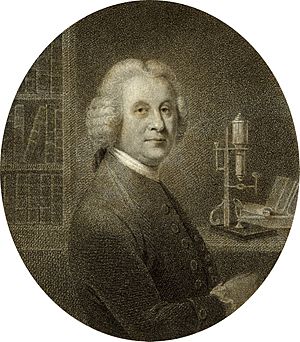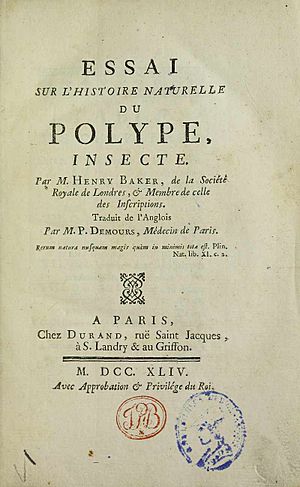Henry Baker (naturalist) facts for kids
Quick facts for kids
Henry Baker
|
|
|---|---|
 |
|
| Born | 8 May 1698 |
| Died | 25 November 1774 (aged 76) |
| Citizenship | British |
| Known for | Microscopy |
| Awards | (1744) Copley gold medal |
| Scientific career | |
| Fields | Naturalist |
Henry Baker (born May 8, 1698 – died November 25, 1774) was a British naturalist. A naturalist is someone who studies nature, like plants and animals. He was especially known for his amazing work with microscopes. He used them to look closely at tiny things that are usually invisible.
Contents
Life
Henry Baker was born in Chancery Lane, London, on May 8, 1698. His father, William Baker, worked as a clerk. When Henry was fifteen, he became an apprentice to John Parker, a bookseller. An apprentice learns a trade or skill by working for an experienced person.
After finishing his apprenticeship in 1720, Baker visited a relative, John Forster. Forster had an eight-year-old daughter who was deaf. Henry Baker became very good at helping deaf people communicate. He developed a special system, which he kept secret, and earned money from his work.
His success in helping deaf people caught the attention of Daniel Defoe, a famous writer. Henry Baker later married Defoe's youngest daughter, Sophia, on April 30, 1729.
In 1740, Henry Baker became a member of the Society of Antiquaries and the Royal Society. These are important groups for people who study history and science. In 1744, he received the Copley gold medal. This award was for his detailed observations of how salt crystals form under a microscope.
He also helped start the Society for the Encouragement of Arts, Manufactures and Commerce in 1754. This group, later called the Society of Arts, encouraged new ideas in art, manufacturing, and trade. Baker worked as its secretary for some time. He passed away in London and was buried at St Mary le Strand.
Universal Spectator
Henry Baker helped start a publication called the Universal Spectator and Weekly Journal in 1728. He worked with Daniel Defoe on this project. The Universal Spectator was more like a collection of essays than a newspaper.
It was published until 1746, with 907 issues in total. Henry Baker was the editor until 1733. John Kelly, another journalist, was one of the first important writers for the publication.
Scientific Works
Henry Baker wrote many articles for the Transactions of the Royal Society. This was a scientific journal. Some of his important books include:
- A Short History of Speech (1723)
- The Microscope made Easy (1743)
- Employment for the Microscope (1753)
In Employment for the Microscope, he wrote about tiny living things he saw in sea water. He called them "Animalcules which cause the Sparkling Light in Sea Water." These were actually dinoflagellates, which are tiny organisms that can make the ocean glow. He was the first to write about them.
Baker also wrote several books of poetry. One of his poems was called The Universe, a Poem intended to restrain the Pride of Man (1727).
Legacy
Henry Baker's name is remembered through the Bakerian Lecture of the Royal Society. He left £100 in his will to create this lecture. It is a special talk given each year by a leading scientist.


